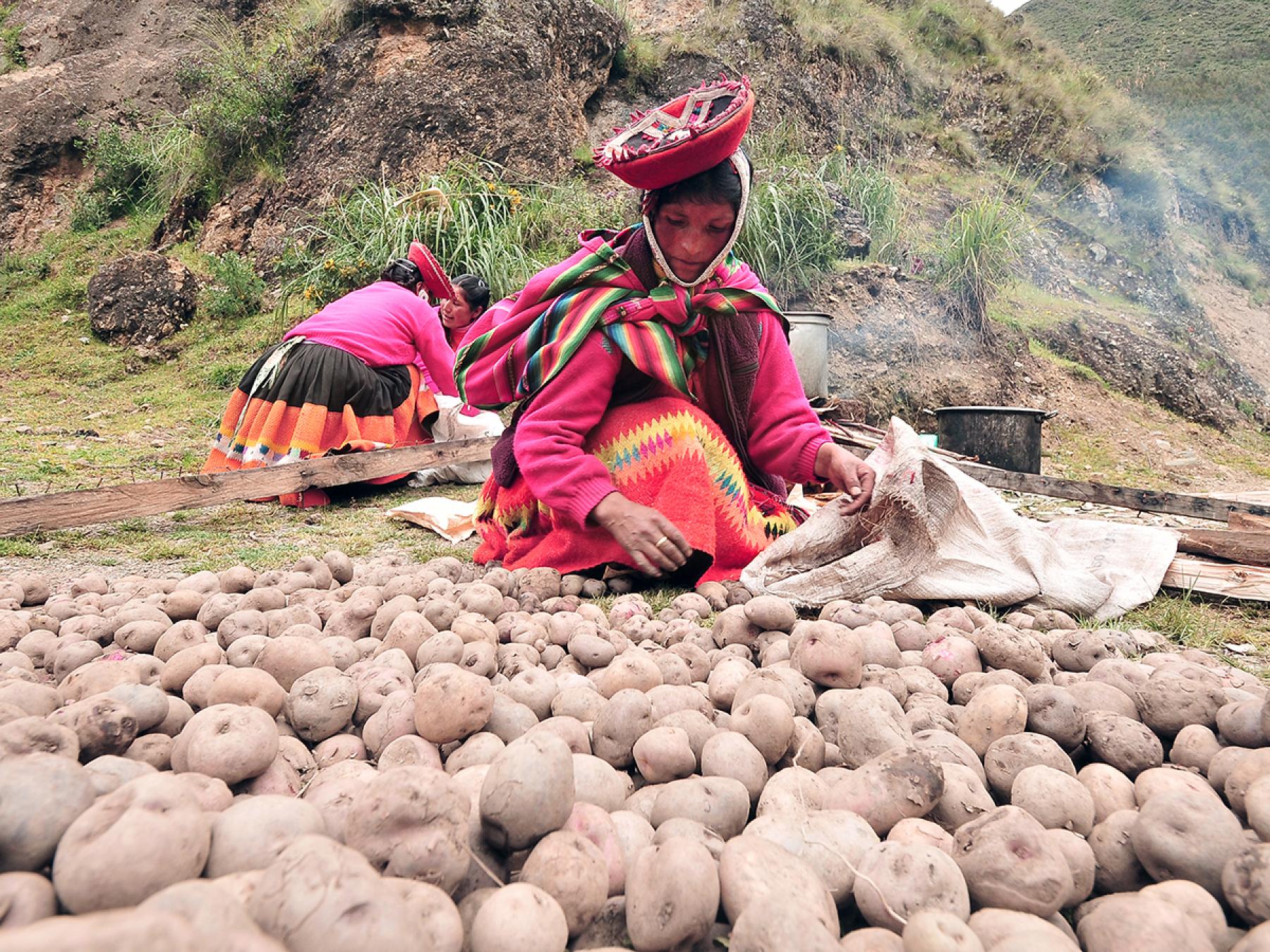The route to most villages in the Andes is a narrow, graded-earth road, in the winter baked concrete-solid under the fierce dry-season sun, in the summer awash with torrents of rain, slick with mud, narrowed or closed by rock-slides. These roads wind tortuously through the mountains, making complicated switchbacks up and down thier flanks or following deep river valleys. The vehicles that ply them, the means of transportation readily available and affordable to most of the inhabitants of those villages, are sometimes small, rattle-trap buses, retired from service on proper roads somewhere else and consigned to end their days travelling perilous mountain routes; or, more often, heavy several-ton trucks with wooden sides and a gate and ladder at the back, which carry everything from grains and potatoes destined for markets in the cites, to livestock and people.
The villages at the ends of these roads of the Peruvian Andes are inhabited for the most part by the Quechua, descendants of the population once ruled by the Inca, whose empire encompassed at its height an aerea from which is now Ecuador, south to Chile, east to Bolivia and center of Peru. In the ensuing centuries, the resilient Quechua have adapted to the cultures superimposed upon their own, adopting elements that were useful to them, like the Old World livestock and crops the Spanish introduced to the Americas. They took the European dress of the conquest period, in most places ad in the a derivative form, is still worn to this day. And more recently they have accept such amenities as running water (in some places) and aluminium pots and pans, radios recod players, and flashlights. Nevertheless, today, although the accoutrements are different, the fundamental outlines of Quechua life remain remarkably as they were in the 16th century resembling life in a medieval European village more than any contemporary way of life.
We might be familiar with.
Harsh agricultural world
Life in the village is simple and hard. Based on subsistence agriculture and pastoralism. Most villages are only marginally connected to the national cash economy through the production of some crops for sale in city markets, and so, as they have since the inception of agriculture in the Andes, each family must produce during the growing season the food for his own substance along the entire year -hopefully, enough to sustain it through a bad year if the crops should ever fail. Amenities are few. Only the larger towns have electricity or even generators. Some villages now have a system of drinkable water, so there may be taps ouside houses or at selected point throughout the village where cold mountain water can be drawn (sparing people a severaltimes-daily trek to a spring or stream to fetch water). The houses are made of adobe bricks or in some places, of ston, with packed each floors and thatched or tiled roofs, the open rafters inside always blackened and sooty from years of smoke from the cooking fire in a hearth in the corner. There is no furniture save perhaps a couple of rudimentary stools, though a more affluent family may have a bed, or a table; women sit, or more often squat, on the floor – a characteristic posture for a Quechua woman – and men sit on earthern benches built against the walls of the house. The family´s possesions consist of their clothing, their pots and pans and cooking and eating utensils, simple agricultural implements and a few other tools, their house and land and animals and usuall, and most prized, a radio. The radio is their sole connection to the rest of the world, ac connection perhaps most valued in years when the World Cup Soccer Tournament is played.
The Quechua inhabit the entire range of altitudes in the complex vertical ecology of the Andes that will sustain human life, from the lushest, sub-tropical river valleys to the high, desolate Puna. Each village exists within a sort of micro-climate that affords it a certain range of crops – from tropical fruits like lemons, limes, oranges, avocados and chilis and a variety of vegetables both familar and exotic.
High-altitude living
The character of each village is in large part determined by the potencial of the land it controls. For a village in the high PUNA, the economy consists mainly of the cultivation of potatoes and high-altitude grains and of herding – mainly of llamas, sheep, a few goats and perhaps a few cattle/ There is little arable land to be conserved and it might be widely dispersed amongst various settlements of small houses of one or two joined or detached rooms,somestimes with a second-story storeroom, built often of stone and roofed with a heavy thatch of Puna grasses. Among the houses might be corrals for the animals, ringed by fences of stacked stone. Around the perimeter of the village will be small potato fields, appearance of corduroy patches on the smooth fabric of short tough puna grasses.
Other towns in this range reveal a markedly dufferent plan. These were the “reductions” created by the Spanish in the 1570s as they gathered together the native population living in scattered settlements throughtout a particular region, for purposes of control and taxation, forced conversion to Catholicism, and, in general, “civilization”. The reductions were laid out according to a plan prescribed by Viceroy Francisco de Toledo, the Spanish king´s of the highlands to determine what would be necessary to govern the new country: they were to be founded in this most temperate zone – deemed to be the most healthy – neither too high nor too low in altitude, near a good souce of water; they were to have peroendicular streets laid out on an ordely grid
